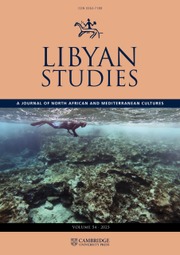Article contents
Non-destructive μXRF analysis of glass and metal objects from sites in the Libyan pre-desert and Fazzan
Published online by Cambridge University Press: 09 September 2015
Abstract
This paper reports on the non-destructive analysis of 42 samples of copper alloy and glass from sites in Libya, using semi-quantitative μXRF, carried out as part of the work of the Trans-Sahara Project funded by the European Research Council. These are among the first chemical analyses to be performed on metals and glasses of any period found in Libya, and the results – though preliminary – raise some interesting possibilities. In particular, we discuss some possible indications with regard to the practice of recycling glasses, as evidenced through heterogeneous, malformed glass beads with variable quantities of lead. A glass mirror from Ghirza was also found to be backed in lead, and was probably the result of a glass-making technique still practised in recent times in India. The metal analysis has revealed evidence of a pre-Islamic trade in brass in the northern Sahara, as well as showing the presence of objects made from the mixing of different types of scrap metal, a process probably taking place at the Garamantian metalworking site of Saniat Jibril among other locations. The importance of further analysis of available Libyan and other North African metal artefacts and glasses for the contextualisation and extension of these findings is emphasised.
يعرض هذا البحث نتائج تحليل عينات غير مدمرة من سبائك نحاسية وزجاج أخذت من مواقع ليبية وحللت باستخدام تقنية الأشعة السينية المتفلورة، ضمن مشروع "عبر الصحراء" الذي موله مجلس البحث الأوروبي . وتعد هذه التحاليل من أوائل التحاليل الكيميائية التي أجريت على المعادن والزجاج في أي فترة في ليبيا. ومع أن النتائج أوليّة، إلا أنها تطرح تساؤلات مهمة لا سيما احتمال وجود مؤشرات على ممارسة عملية تدوير الزجاج التي تظهر بوضوح من خلال عدم تجانس حبيبات الزجاج واختلاطها بكميات متفاوتة من الرصاص . كما وُجدت مرآة زجاجية في منطقة غرزة ظهر في تركيبها كمية من الرصاص، وربما نتج ذلك عن تقنية خاصة لصناعة الزجاج لا زالت تستخدم حتى الآن في الهند.
لقد كشف تحليل المعادن عن أدلة تشير إلى ظهور تجارة النحاس شمال الصحراء قبل الإسلام، وهناك أدلة أخرى تظهر وجود مواد صُنعت من خليط من بقايا معادن مختلفة، ربما صُنعت في ورش الجرمنتيين، سكان ليبيا القدامى، في سانية جبريل وغيرها من المواقع . يؤكد البحث على أهمية إجراء المزيد من التحاليل على القطع الزجاجية والمعدنية المتوفرة في ليبيا وشمال إفريقيا لتطوير هذه النتائج ووضعها في سياقها المناسب .
Information
- Type
- Articles
- Information
- Copyright
- Copyright © The Society for Libyan Studies 2015
References
- 12
- Cited by

